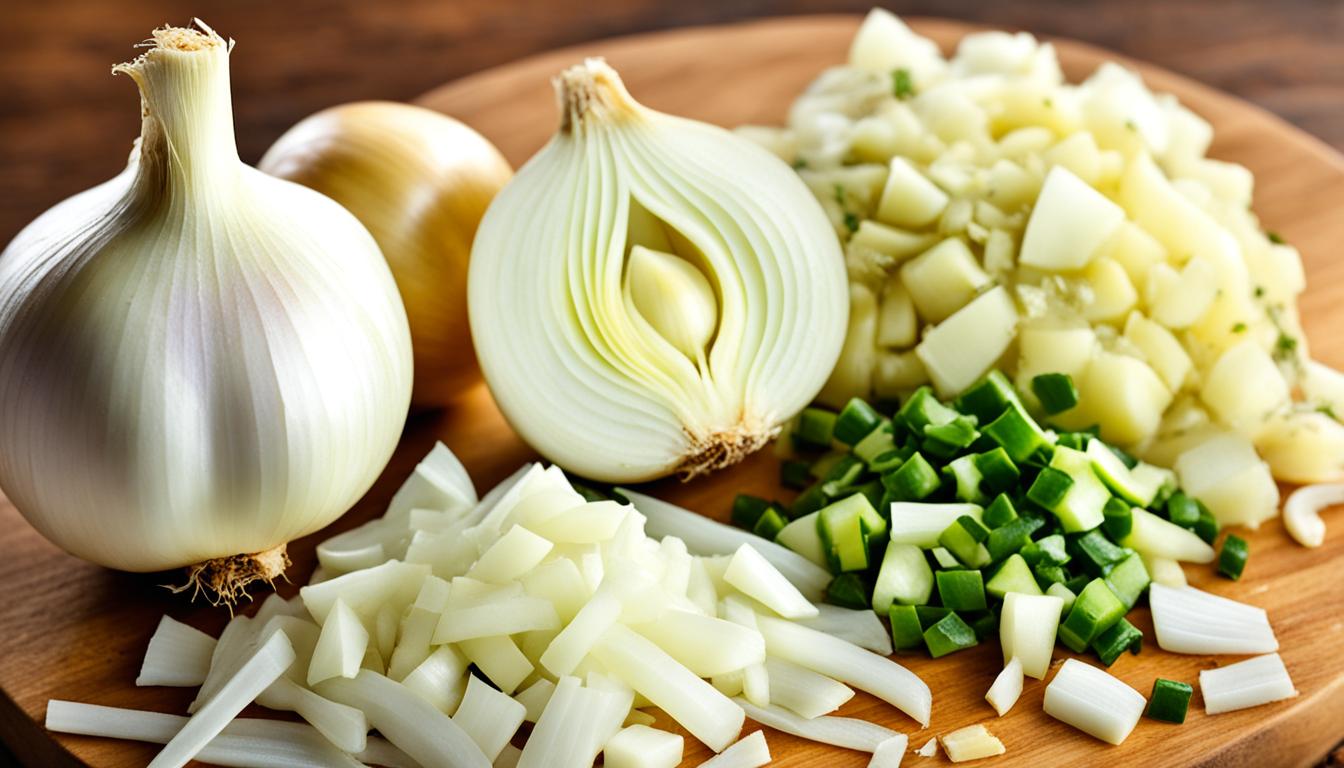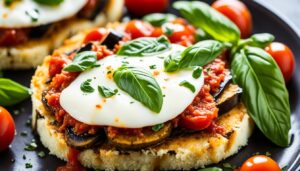Onions are key in many recipes. Ever thought about how yellow and white onions differ? We’ll dive into their flavors and cooking tips. This way, you can pick the right onion and boost your meals.
Key Takeaways
- Yellow onions have a bolder flavor and hold their shape better when cooked.
- White onions are milder, sweeter, and more tender.
- The choice between yellow and white onions depends on the desired flavor profile and texture in a recipe.
- Both yellow and white onions offer nutritional benefits, including low calories, high fiber, vitamins, minerals, antioxidants, and anti-inflammatory compounds.
- Yellow onions are versatile and commonly used in sautéed dishes, pizza, burgers, sandwiches, and caramelizing.
Nutritional Benefits of Yellow and White Onions
Yellow and white onions are healthy for your diet. They look and taste a bit different but are nutritionally similar.
These onions are low in calories, perfect for weight management. They’re rich in dietary fiber, which helps digestion and keeps your gut healthy.
Onions are packed with important vitamins and minerals. They have vitamin C, boosting your immune system. They also offer vitamin B6, crucial for your brain and mood.
Both onion types contain potassium, vital for heart health and maintaining normal blood pressure.
They have antioxidants and anti-inflammatory compounds, too. These fight cell damage, reduce body inflammation, and could even lower cancer risk.
Whether you like yellow onions or white ones, they’re both nutritious. Choosing either is beneficial.
Comparison of Nutritional Content (For 100g serving)
| Nutrient | Yellow Onion | White Onion |
|---|---|---|
| Calories | 40 | 42 |
| Dietary Fiber | 1.7g | 1.3g |
| Vitamin C | 8% of Daily Value (DV) | 9% of DV |
| Vitamin B6 | 6% of DV | 5% of DV |
| Potassium | 5% of DV | 4% of DV |
Note: Nutritional content can differ by onion variety and size.
Best Uses for Yellow Onions
Yellow onions are a must-have in the kitchen, fitting in many recipes. They are perfect for cooking because they keep their shape and taste strong. If you’re looking for that bold onion flavor, yellow onions are your best choice.
They’re great as toppings for pizzas, burgers, or sandwiches, making any meal tastier. Yellow onions can be caramelized or blackened. This adds a rich flavor to stocks, broths, and more.
Recipes Featuring Yellow Onions:
- French Onion Soup: The sweet and savory notes of yellow onions shine in this classic comforting soup.
- Stir-Fried Vegetables: Sautéing yellow onions with a medley of vegetables creates a fragrant and delicious side dish.
- Onion Rings: Dip slices of yellow onions in a seasoned batter and deep-fry them until golden brown for a crispy and satisfying appetizer.
Yellow onions are key for adding bold flavor and texture to your meals. They’re a staple for many recipes, enhancing everything from savory stews to zesty salsas.
| Yellow Onions | Best Uses |
|---|---|
| Sautéed Dishes | Yellow onions hold their shape well and add a robust flavor to sautéed dishes. |
| Toppings | Add a flavorful punch as a topping for pizzas, burgers, and sandwiches. |
| Caramelizing/Blackening | Build depth and intensity in dishes like stocks and broths. |
Best Uses for White Onions
White onions have a milder, sweeter taste. They make dishes like salads, salsas, and sandwiches taste better. When you slice them thin, they make your plate look and taste great.
White onions are great in cooked dishes too. They work well in goulash, stews, and slow-cooked meals. They add a unique flavor and improve the texture. Whether raw or cooked, white onions make your food better.
Quotes:
“When it comes to adding a gentle touch to raw dishes, white onions take the prize. They bring out the flavors without overpowering the other ingredients.” – Chef Emily Jones
“White onions are versatile – they can provide a subtle crunch or a soft, sweet essence, depending on how they’re prepared. Their ability to melt away when cooked makes them perfect for hearty stews and casseroles.” – Chef Michael Smith
Recipe Ideas:
- White Onion and Tomato Salad
- Grilled Chicken Sandwich with White Onion Slices
- Seafood Ceviche with White Onion
- Beef Stew with Melt-in-Your-Mouth White Onions
Differences in Appearance and Availability
Yellow and white onions look very different. Yellow onions have dark yellow or brown skin. Their flesh has a golden tone. White onions, however, have white skin and a white inside.
Yellow onions are easier to find in the U.S. They make up a big part of the onion crop. You can find them at grocery stores and farmers’ markets. White onions, though, might cost a bit more. They are seen as a special kind of onion. You can find them in certain stores or places that sell unique foods.
Cooking Tips for Onions
When cooking with onions, it’s key to pick the right type for your dish. The choice between yellow onions and white onions depends on the taste and texture you want. Here are some tips to help you use onions effectively:
Yellow Onions: Bold Flavor and Texture
Yellow onions are known for their strong flavor and firm texture. They’re perfect for dishes where the onion flavor is central.
Use yellow onions in:
- Soups and stews
- Roasts and braises
- Grilled or sautéed dishes
They bring depth and complexity to these dishes, making them kitchen essentials.
White Onions: Delicate and Tender
White onions have a milder, sweeter taste than yellow onions. They work well in dishes where you want a gentle onion flavor.
Use white onions in:
- Salads and salsas
- Sandwiches and wraps
- Raw vegetable platters
They mix well with other flavors, without taking over the dish.
Tip: Soak raw onions in cold water for 10-15 minutes to reduce their sharpness. This makes them more mellow.
Yellow and white onions can usually be swapped in recipes. This won’t change the dish’s flavor much. Try both types and see which you like best in different recipes.
Cooking with onions means balancing flavors to please your palate. Whether you choose yellow onions for their boldness or white onions for their sweetness, each type enriches your cooking.
Other Onion Varieties
Yellow onions and white onions are common, but other types also offer unique tastes. Trying different onions can make your food more exciting. Consider these onion varieties:
Red Onions
Red onions bring a tangy sweetness to your meals. They’re perfect in salsas, sandwiches, and uncooked foods. Their purple color makes any salad or recipe look great.
Cipollini Onions
Cipollini onions are tiny and sweet, looking like flying saucers. With a mild taste, they’re excellent for roasting or caramelizing. Use them when you want to reveal their sweetness in your cooking.
Pearl Onions
Pearl onions are little and found in white, yellow, and red kinds. Often in the freezer aisle, they’re ideal for stews, soups, and roasts. These onions add a gentle sweetness and a nice bite.
Shallots
Shallots are bigger onions that taste mild and a bit sweet. They’re great for dressings, sauces, and sides. Shallots can be cut in many ways to boost your dishes’ flavor.
Comparison of Onion Varieties
Here’s a quick guide to understand the differences between these onions. Check the table below:
| Onion Variety | Flavor | Best Uses |
|---|---|---|
| Yellow Onions | Strong, bold flavor | Sautéing, caramelizing, cooked dishes |
| White Onions | Milder, sweeter flavor | Raw, salads, salsas, deli-style sandwiches |
| Red Onions | Tangy, sweet flavor | Salsas, fresh recipes, sandwiches |
| Cipollini Onions | Delicate, sweet flavor | Roasting, caramelizing |
| Pearl Onions | Subtle sweetness, small size | Stews, soups, roasts |
| Shallots | Mild, slightly sweet flavor | Dressings, sauces, side dishes |
Experiment with these onion types for exciting, tasty dishes. Whether you need strong flavor or gentle sweetness, there’s an onion for every dish.
Selecting and Storing Onions
Choosing the right onions can make your dishes taste amazing. Yellow and white onions each bring different flavors and textures. Here’s how to pick and keep them fresh.
Choosing the Right Onions
Pick yellow or white onions that are firm and heavy. They should have dry, papery skin and no bruises. Avoid any that feel soft or show signs of mold.
Tip: Comparison
Yellow onions pack a bold flavor. White onions are milder and sweeter. Think about the taste you want in your dish when choosing.
Storing Onions
Store both yellow and white onions in a cool, dry place. They do best in well-ventilated spots away from moisture. A pantry or cellar works great.
If you’ve cut an onion and have leftovers, wrap the cut end with plastic. Or use an airtight container. Put the rest in the fridge for the best freshness. Using glass helps avoid smells spreading to other food.
Image:
| Yellow Onions | White Onions |
|---|---|
| Bolder flavor | Milder and sweeter taste |
| Hold shape better when cooked | More tender and break down easily when cooked |
| Commonly used for sautéed onion dishes, caramelizing, or blackening | Ideal for raw preparations, salads, and fresh recipes |
Follow these tips for fresh, flavorful onions in your meals. Choose firm, unblemished onions. Keep them cool and dry. Enjoy the rich flavors yellow and white onions add to your cooking!
Tips for Reducing Onion Pungency
If onions are too sharp for you, there are several ways to make them milder. This is useful for recipes needing a softer onion flavor. Whether using yellow or white onions, these tips will make them less pungent.
Soaking in Water
Soaking onions in water is a great way to soften their flavor. Just leave sliced or chopped onions in cold water for 30 minutes to 1 hour. This draws out sharp compounds. After soaking, drain them and add to your dish. This trick works well with both yellow and white onions, giving dishes a milder onion taste.
Cooking Onions
Cooking onions is another way to make them less sharp. Heating onions softens their strong scent and taste, leaving them sweeter. Sautéing or caramelizing them for a long time breaks down the sharp compounds. This is great for white onions, making them softer and sweeter than yellow ones.
Raw Onion Precautions
Cutting raw onions releases compounds that can make your eyes tear up and increase their sharpness. Chilling onions before cutting or using a sharp knife lessens this effect. For those sensitive to raw onions’ smell and taste, try using soaked or cooked onions in your dishes for a gentler flavor.
| Method | Description |
|---|---|
| Soaking in Water | Place sliced or chopped onions in cold water for 30 minutes to 1 hour to reduce their pungency. |
| Cooking Onions | Cooking onions helps to mellow their flavor by decreasing their pungent scent and taste. |
| Raw Onion Precautions | Raw onions release sulfuric compounds when cut, which can irritate the eyes and enhance their pungency. Take precautions when handling raw onions. |
These tips can make onion flavor better match your cooking needs. Soaking or cooking onions softens their sharp taste. Be careful with raw onions to keep their strong flavor in check. No matter if you’re using yellow or white onions, these strategies will help you fine-tune their taste in your meals.
Yellow Onion vs White Onion: Which is Better?
Choosing between yellow onions and white onions depends on your taste. Each type of onion brings a unique flavor and can make a dish stand out. Let’s dive into the differences to see which onion best fits your cooking needs.
Flavor
Yellow onions offer a strong, sharp taste. This makes them great for giving savory dishes like soups and stews a rich flavor. White onions are milder and a bit sweet. They’re perfect when you need a soft onion taste, not overshadowing other flavors.
Cooking Uses
Yellow onions and white onions shine in different ways when cooked. Yellow ones are ideal for caramelizing or roasting due to their sturdy nature. They bring out a deep flavor in any dish. White onions are best raw in salads or quick-cooked meals like stir-fries. Their mild taste and crispness add a fresh touch.
Texture
Yellow onions have a firm, dense texture. This makes them great for dishes where you want the onions to stand out. They stay intact in meals that need more cooking time. White onions are softer and blend well when cooked. They’re great for dishes needing a gentle onion flavor without chunky pieces.
Versatility
Though yellow and white onions differ slightly in taste and texture, they can be swapped in recipes. Both add a delicious onion flavor to any meal, from soups to salads. Ultimately, the choice depends on your preference and the taste you’re aiming for in your cooking.
Other Onion Varieties and Recipe Ideas
Beyond yellow and white onions, many other types exist with their own special tastes. These varieties can make your meals more interesting. Try some of them to enhance your recipes:
Red Onions
Red onions are both tangy and sweet, fitting perfectly into various recipes. They shine in salsas, sandwiches, and salads. Their bright color also makes meals more attractive.
Cipollini Onions
Cipollini onions are small, sweet, and look like flying saucers. They’re great for roasting as the heat brings out a caramel-like sweetness. These onions are excellent in roasted veggies or as pizza toppings.
Pearl Onions
Pearl onions come in white, yellow, and red colors. They’re mildly sweet and complement many dishes well. Use them in roasts, stews, and braised recipes for an elegant touch. You can find them in the frozen section.
Shallots
Shallots are bigger than regular onions and boast a gentle taste. Often seen as a mix of onion and garlic, they add a subtle garlic hint. They’re ideal in dressings, marinades, and sauces, enriching your food.
Using these various onions can bring new dimensions to your cooking. They can make anything from salads to side dishes more exciting.
Conclusion
Yellow and white onions are key for many dishes because they have unique tastes and textures. Yellow onions are strong and hold up well when cooked. This makes them perfect for dishes that need cooking, like in soups or when caramelizing. White onions are milder and softer, great for fresh meals like salads or sandwiches.
It’s okay to swap yellow and white onions in recipes, but think about what your meal needs. Following the recipe is smart if it asks for a certain onion type. Yet, trying different onions can also make your food taste even better.
In any dish, from stews to salads, yellow and white onions do wonders. Use their distinct flavors to experiment and enhance your cooking. Happy cooking with these adaptable onions in your kitchen!





